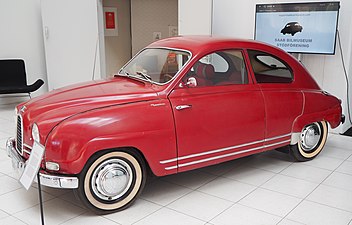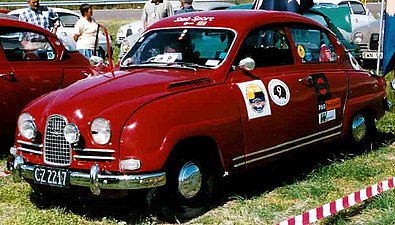
A two-strokeengine is a type of internal combustion engine that completes a power cycle with two strokes of the piston in one revolution of the crankshaft. A four-stroke engine requires four strokes of the piston to complete a power cycle in two crankshaft revolutions. In a two-stroke engine, the end of the combustion stroke and the beginning of the compression stroke happen simultaneously, with the intake and exhaust functions occurring at the same time.
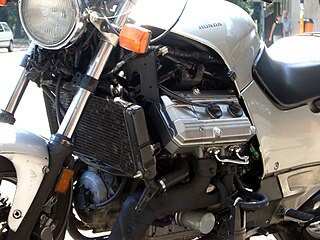
A V4 engine is a four-cylinder piston engine where the cylinders share a common crankshaft and are arranged in a V configuration.

A straight-three engine is a three-cylinder piston engine where cylinders are arranged in a line along a common crankshaft.

The Saab 99 is a car produced by Swedish manufacturer Saab from 1968 to 1984; their first foray into a larger class than the Saab 96. While considered a large family car in Scandinavia, it was marketed as a niche compact executive car in most other markets. It was manufactured both in Sweden and Finland and was succeeded by the Saab 900, although the 99 continued to be produced alongside its successor. The Saab 90, an updated, less complex version using many 900 parts took over from the 99 in late 1984.

The Saab 95 is a seven-seater, two-door station wagon produced by Swedish automaker Saab from 1959 to 1978.

The Saab 96 is an automobile manufactured and marketed by Swedish automaker Saab from 1960 to January 1980, replacing the Saab 93. The 96 featured aerodynamic two-door bodywork, four-passenger seating and at first a two-stroke, three-cylinder engine, later a four-stroke V4.
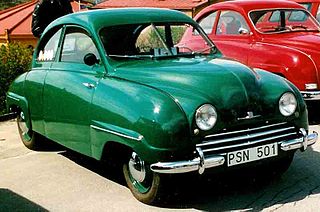
The Saab 92 was the first production car from Saab. The design was very aerodynamic for its time, with a drag coefficient of 0.30. The entire body was stamped out of one piece of sheet metal and then cut to accommodate doors and windows. Full-scale production started December 12, 1949, based on the prototype Ursaab. All of them were of the Deluxe version. A standard version was advertised, but nobody was interested in buying it so no standard versions were produced.

The Saab Sonett is an automobile manufactured by Swedish automaker Saab between 1955 and 1957 and again between 1966 and 1974. Sonetts share engines and other components with Saab 93, 95 and 96 of the same era. It was mainly intended for the lucrative American export market and was only offered intermittently in the Swedish domestic market.
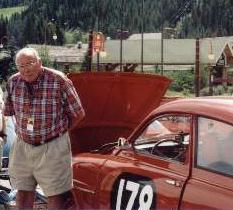
Erik Hilding Carlsson was a Swedish rally driver for Saab. He was nicknamed "Carlsson på taket" as well as Mr. Saab.

The Subaru 360 is a rear-engined, two-door city car manufactured and marketed by Subaru from 1958 to 1971. As the company's first mass-produced automobile, production reached 392,000 over its 12-year model run.

The Ford Taunus V4 engine is a 60° V4 piston engine with one balance shaft, introduced by Ford Motor Company in Germany in 1962. The German V4 was built in the Cologne plant and powered the Ford Taunus and German versions of the Consul, Capri, and Transit.

The Chevrolet small-block engine is a series of gasoline-powered V8 automobile engines, produced by the Chevrolet division of General Motors between 1954 and 2003, using the same basic engine block. Referred to as a "small-block" for its size relative to the physically much larger Chevrolet big-block engines, the small-block family spanned from 262 cu in (4.3 L) to 400 cu in (6.6 L) in displacement. Engineer Ed Cole is credited with leading the design for this engine. The engine block and cylinder heads were cast at Saginaw Metal Casting Operations in Saginaw, Michigan.

The Billancourt engine was an automotive engine designed by Renault for the Renault 4CV, used subsequently until 1985. It later received the internal code "B", for Billancourt. The "sport" version is called Ventoux engine.

The E-series was a line of inline four-cylinder automobile engines designed and built by Honda for use in their cars in the 1970s and 1980s. These engines were notable for the use of CVCC technology, introduced in the ED1 engine in the 1975 Civic, which met 1970s emissions standards without using a catalytic converter.

The Lancia Fulvia is a car produced by Lancia between 1963 and 1976. Named after Via Fulvia, the Roman road leading from Tortona to Turin, it was introduced at the Geneva Motor Show in 1963 and manufactured in three variants: Berlina 4-door saloon, 2-door Coupé, and Sport, an alternative fastback coupé designed and built by Zagato on the Coupé floorpan.

The Saab B engine is an inline four-cylinder car petrol engine developed by Saab Automobile. A redesign of the Triumph slant-four engine, the B engine displaced 2.0 L and first appeared in 1972. The B engine was used in the Saab 99 and 900 models. Saab began to phase the engine out in 1981.

The Nissan L series of automobile engines was produced from 1966 through 1986 in both inline-four and inline-six configurations ranging from 1.3 L to 2.8 L. It is a two-valves per cylinder SOHC non-crossflow engine, with an iron block and an aluminium head. It was the engine of the Datsun 510, Datsun 240Z sports car, and the Nissan Maxima. These engines are known for their reliability, durability, and parts interchangeability.

The Lancia Rally was a mid-engine sports car and rally car built by Lancia in the early 1980s to compete in the FIA Group B World Rally Championship. Driven by Markku Alén, Attilio Bettega, and Walter Röhrl, the car won Lancia the manufacturers' world championship in the 1983 season. It was the last rear-wheel drive car to win the WRC.

The Saab two-stroke was a two-stroke cycle, inline, two cylinder, and later three cylinder engine manufactured by Swedish automotive manufacturer Saab that was based on a design by German manufacturer DKW.
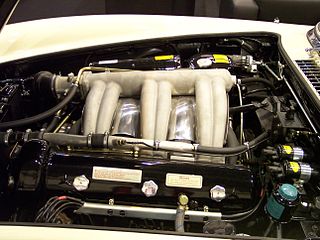
The Mercedes Benz M186 Engine was a 3.0–litre single overhead camshaft inline-6 developed in the early 1950s to power the company's new flagship 300 "Adenauer" (W186) four-door saloon. It made its debut at the Frankfurt Motor Show in April 1951.

